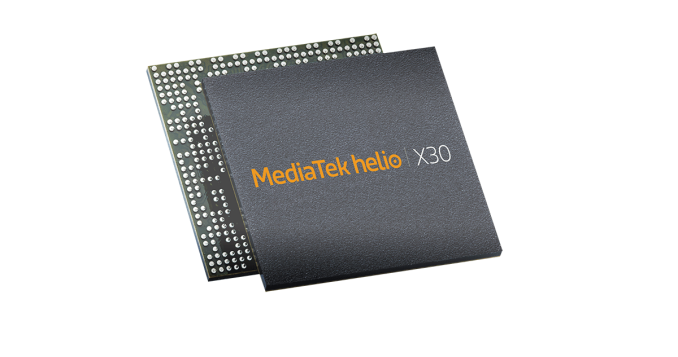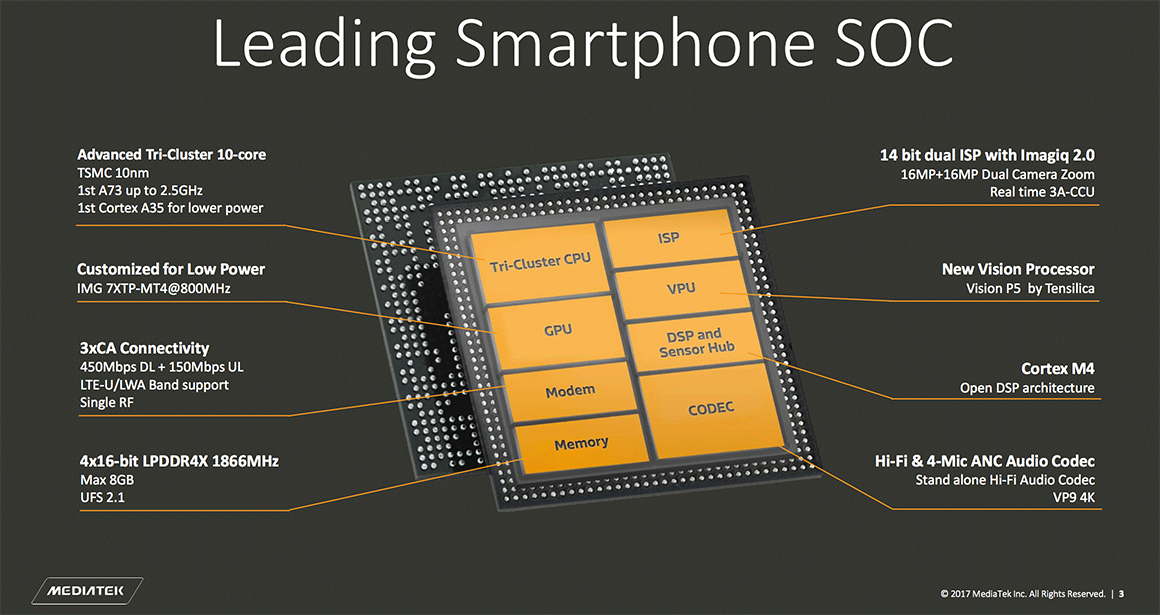MediaTek Announces Helio X30 Availability: 10 CPU Cores On 10nm
by Matt Humrick on February 27, 2017 8:35 PM EST- Posted in
- Smartphones
- Mobile
- Trade Shows
- SoCs
- MediaTek
- Helio
- MWC_2017
- Helio X30

MediaTek first unveiled the Helio X30—its next-generation high-end SoC—last fall, but today at Mobile World Congress the Taiwanese company announced its commercial availability. The Helio X30 is entering mass production and should make its debut inside a mobile device sometime in Q2 2017.
The Helio X30, like the Helio X20 family before it, incorporates 10 CPU cores arranged in a Max.Mid.Min tri-cluster configuration. Two of ARM’s latest A73 CPU cores replace the two A72s in the Max cluster, which should improve performance and reduce power consumption. The Mid cluster still uses 4 A53 cores, but they receive a 10% frequency boost relative to the top-of-the-line Helio X27. In the X30’s Min cluster we find the first implementation of ARM’s most-efficient A-series core. The A35 consumes 32% less power than the A53 it replaces (same process/frequency), while delivering 80%-100% of the performance, according to ARM. With a higher peak frequency of 1.9GHz, the X30’s A35 cores should deliver about the same or better performance than the X20’s A53 cores and still consume less power.
| MediaTek Helio X20 vs. Helio X30 | ||
| SoC | MediaTek Helio X20 |
MediaTek Helio X30 |
| CPU | 2x Cortex-A72 @2.1GHz 4x Cortex-A53 @1.85GHz 4x Cortex-A53 @1.4GHz |
2x Cortex-A73 @2.5GHz 4x Cortex-A53 @2.2GHz 4x Cortex-A35 @1.9GHz |
| GPU | ARM Mali-T880MP4 @780MHz |
PowerVR 7XTP-MT4 @800MHz |
| Memory Controller |
2x 32-bit @ 933MHz LPDDR3 14.9GB/s b/w |
4x 16-bit @ 1866MHz LPDDR4x 29.9GB/s b/w |
| Video Encode/ Decode |
encode: 2160p30 H.264 / HEVC w/HDR decode: 2160p30 10-bit H.264 / HEVC / VP9 |
encode: 2160p30 H.264 / HEVC w/HDR / VP9 decode: 2160p30 10-bit H.264 / HEVC / VP9 |
| Camera/ISP | Dual ISP 32MP @ 24fps (single camera) or 13MP + 13MP @ 30fps (dual camera) |
Dual 14-bit ISP 28MP @ 30fps (single camera) or 16MP + 16MP (dual camera) |
| Integrated Modem |
LTE Category 6 DL = 300Mbps 2x20MHz CA, 64-QAM UL = 50Mbps 1x20MHz CA, 16-QAM FDD-LTE / TD-LTE / TD-SCDMA / WCDMA / CDMA / GSM |
LTE Category 10 DL = 450Mbps 3x20MHz CA, 64-QAM UL = 150Mbps 2x20MHz CA, 64-QAM FDD-LTE / TD-LTE / TD-SCDMA / WCDMA / CDMA / GSM |
| Mfc. Process | TSMC 20SoC (planar) | TSMC 10nm FinFET |
The Helio X30 will also be the first SoC to use TSMC’s 10nm process, which will offer significant power savings relative to TSMC’s 20nm planar process that the Helio X20 family uses. According to MediaTek, the X30 consumes 50% less power than the X20 when running an unspecified CPU workload and 60% less power when running GFXBench T-Rex. These power savings will increase battery life and improve sustained performance with less thermal throttling.
Alongside the Helio X30, MediaTek is launching CorePilot 4.0, which manages CPU frequency and task scheduling. Optimized for its unique tri-cluster CPU configuration, CorePilot keeps track of the SoC’s power budget by monitoring temperature, and the global task scheduler component is responsible for migrating tasks between clusters based on workload and user experience parameters, such as frames per second. It also adjusts CPU frequency using Fast DVFS technology that increases sampling rate, allowing for faster voltage/frequency adjustments that better follow changes in workload. The overall goal of CorePilot 4.0 is to achieve the best possible performance at the lowest power levels.
In a short presentation at its MWC booth Monday, Executive Vice President & Co-COO Jeffrey Ju stated that MediaTek expects only a limited number of phones to use the Helio X30, perhaps less than ten. He also mentioned that a low yield rate for TSMC’s 10nm process has delayed the X30’s availability. The X30 sounds compelling on paper, so it will be interesting to see how many design wins it can actually achieve.











57 Comments
View All Comments
lucam - Thursday, March 2, 2017 - link
Was gonna ask same question...Krysto - Tuesday, February 28, 2017 - link
Finally seeing Cortex-A35 in a chip. Although it seems they've still kept Cortex-A53. That's interesting because Cortex-A35 is supposed to have higher IPC than A53, no? Perhaps it can't reach as high of a peak.Lodix - Tuesday, February 28, 2017 - link
If you read the article you will see that it has 80-100% the ipc of the A53 consuming less power.Meteor2 - Tuesday, February 28, 2017 - link
Yes indeed, its absence has been notable. Perhaps it can't clock as high as A53 so it's too slow or as a previous commenter said, the model number is bad for marketing.Matt Humrick - Tuesday, February 28, 2017 - link
It has more to do with development cost. If you already have an A53 design, it's more cost effective to give it a few tweaks and reuse than start over with a new core you have no previous experience with.Krysto - Tuesday, February 28, 2017 - link
Also, I'm glad MediaTek is finally using a competitive process node. This will actually be MediaTek's first time to compete toe-to-toe with Qualcomm and Samsung. Let's see how they do.SharpEars - Tuesday, February 28, 2017 - link
I once again ask the obvious: Who the hell wants 30 Hz refresh at 4k? If you can't do at least 60 Hz, don't advertise the resolution!extide - Sunday, May 7, 2017 - link
That's only for decode and most video streams are only at 24/25/30 fps anyways -- so perfect;y fine. The refresh rate is not constrained by the decode ratesabufrejoval - Tuesday, February 28, 2017 - link
This chip looks outstanding and very much like it could compete on par with Samsung's newest Exynos and Qualcomms 835.And since Samsung doesn't sell Exynos to anyone and buys all available Qualcomms perhaps it's the only choice left for the rest of the crowd.
I'd certainly like to see some larger tablets or RemixOS type notebooks at budget prices with it.
I'm sick and tired of "Edge" designed premium smartphones consuming all high-end ARM SoCs while tablets and (dare I say it?) netbooks get nothing but mid-range or Intel.
I still like my original Asus TF101 Transformer, but with a non-NEON Tegra2 dual core and 1GB of RAM it's in need of an update, even if it still holding up very well mechanically and in battery time.
serendip - Tuesday, February 28, 2017 - link
Three clusters and ten cores? Because ten is better than eight?I don't get Mediatek's reasoning for this design. There's already a performance penalty for moving tasks from one cluster to another; I can't imagine what it's like to move tasks from the first to the second and then to the third cluster. They should have gone with a quad A35 and dual or quad A73 setup. It's funny that a newer X20 in the Redmi Note 4 has less performance and uses more power than a Snapdragon 650 on an ancient process node.